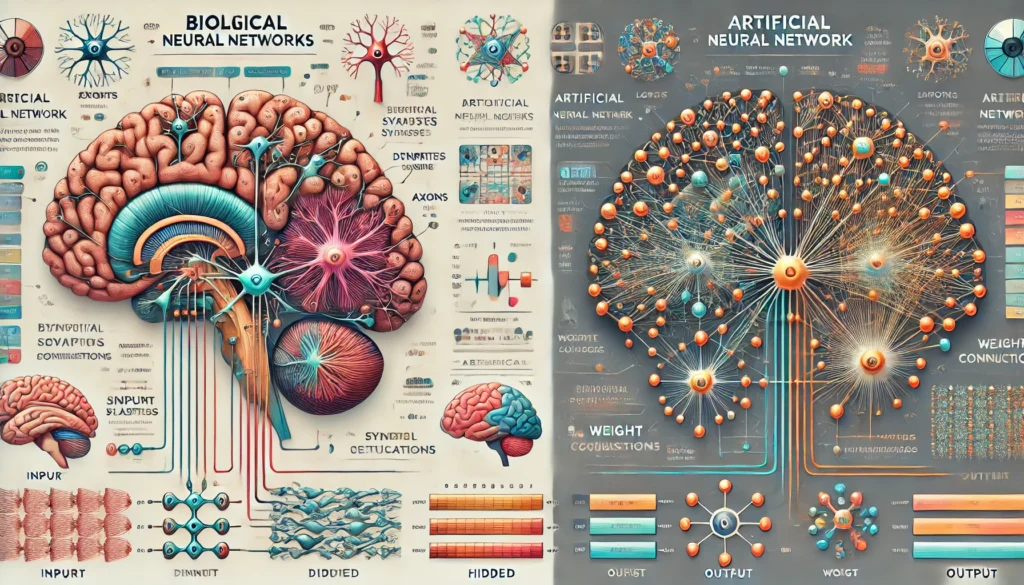Network computation in neural systems is a field at the intersection of neuroscience, cognitive science, and computer science. It involves studying how networks of neurons process information, communicate, and learn. This interdisciplinary approach leverages computational models and theories to understand the complex workings of neural systems, both in humans and other organisms.
The Basics of Neural Networks
Neural networks, both biological and artificial, consist of interconnected nodes (neurons in biological systems) that transmit information through electrical and chemical signals. In biological neural networks, this process involves the propagation of signals through synapses, which are the connections between neurons. These networks are capable of processing information by adjusting the strength of these connections based on the stimuli they receive, a fundamental process known as synaptic plasticity.
Artificial neural networks (ANNs) mimic this behavior using mathematical models, where nodes and connections represent neurons and synapses, respectively. These models are structured in layers, including input layers that receive data, hidden layers that process data, and output layers that produce the final results of the computation.
Computational Models in Neuroscience
Computational models in neuroscience are crucial for simulating and understanding brain functions. These models help scientists hypothesize how neural circuits could perform complex cognitive tasks such as learning, memory, and decision-making. By adjusting the parameters of these models and observing the outcomes, researchers can infer how similar adjustments in biological neural networks might affect behavior and cognitive functions.
Applications of Network Computation
The applications of network computation in neural systems are vast and influential. In medicine, these models assist in understanding the progression of neurological diseases like Alzheimer’s and Parkinson’s by simulating how disruptions in neural networks affect cognitive functions. In technology, insights from neural network computation fuel advancements in artificial intelligence and machine learning, leading to more sophisticated algorithms capable of performing tasks that require human-like understanding and decision-making.
Challenges and Future Directions
Despite significant advancements, network computation in neural systems faces numerous challenges. One major challenge is the complexity of biological neural networks, which are incredibly dense and intricate. This complexity makes it difficult to create accurate models that can predict real-world neural behavior in detail. Additionally, ethical concerns arise when applying these computational models, particularly in AI development, where decisions made by algorithms can have profound impacts on individuals and societies.
The future of network computation in neural systems looks promising, with ongoing research pushing the boundaries of what computational models can achieve. Improvements in computing power and techniques, like deep learning, are making it possible to simulate larger and more complex networks, providing deeper insights into both biological and artificial neural systems.
Conclusion
Network computation in neural systems is a dynamic field that blends empirical research with theoretical models to explore the fundamentals of cognition and neural functionality. As this field evolves, it promises to not only enhance our understanding of the brain but also pave the way for innovations in artificial intelligence, ultimately leading to more robust and capable computational systems.
How do computational models help in neuroscience?
Computational models allow scientists to simulate neural processes and predict outcomes of experiments, helping to understand complex brain functions like memory, learning, and decision-making. These models provide a framework for testing hypotheses about brain mechanisms in a controlled and repeatable environment.
What are the applications of network computation?
The applications range from medical (e.g., understanding and treating neurological diseases) to technological advancements (e.g., improving artificial intelligence systems). These models are fundamental in developing algorithms that mimic human cognition and in studying the progression of neurodegenerative diseases.
What challenges does network computation face?
Major challenges include the complexity of accurately modeling biological neural networks, which are highly intricate and variable. Ethical concerns also arise, particularly in AI development, where decisions made by algorithms can significantly affect people’s lives.
What is the future of network computation in neural systems?
The future holds promising advancements in computing power and methodologies like deep learning, which could enable more accurate simulations of larger and more complex neural networks. This progress is expected to provide deeper insights into brain functions and further innovations in AI.


